Clinical Reasoning Cycle for Medication Management and Self-Management in Type 2 Diabetes
VerifiedAdded on 2023/01/18
|9
|2268
|79
AI Summary
This essay addresses a medical case study on type 2 diabetes through Levett Jones clinical reasoning cycle for facilitating optimal care with rationale and logical validation. The essay focuses on medication management and self-management issues.
Contribute Materials
Your contribution can guide someone’s learning journey. Share your
documents today.

NUR2102
STUDENT ID
[DATE]
HP
[Company address]
STUDENT ID
[DATE]
HP
[Company address]
Secure Best Marks with AI Grader
Need help grading? Try our AI Grader for instant feedback on your assignments.

Contents
INTRODUCTION.................................................................................................................................2
CLINICAL REASONING CYCLE.......................................................................................................2
PROCESSING OF INFORMATION................................................................................................2
IDENTIFICATION OF PROBLEM..................................................................................................3
ESTABLISH GOALS.......................................................................................................................3
NURSING ACTIONS AND RATIONALE......................................................................................4
ISSUE 1 – POLYPHARMACY AND MEDICATION MANAGEMENT....................................4
INTERVENTION..........................................................................................................................4
RATIONALE................................................................................................................................4
INTERVENTION 2.......................................................................................................................4
RATIONALE 2.............................................................................................................................5
ISSUE 2 –SELF MANAGEMENT...................................................................................................5
INTERVENTION..........................................................................................................................5
RATIONALE................................................................................................................................5
EVALUATION OF OUTCOMES....................................................................................................5
REFLECTION...................................................................................................................................6
CONCLUSION.....................................................................................................................................6
REFERENCES..........................................................................................................................................7
INTRODUCTION.................................................................................................................................2
CLINICAL REASONING CYCLE.......................................................................................................2
PROCESSING OF INFORMATION................................................................................................2
IDENTIFICATION OF PROBLEM..................................................................................................3
ESTABLISH GOALS.......................................................................................................................3
NURSING ACTIONS AND RATIONALE......................................................................................4
ISSUE 1 – POLYPHARMACY AND MEDICATION MANAGEMENT....................................4
INTERVENTION..........................................................................................................................4
RATIONALE................................................................................................................................4
INTERVENTION 2.......................................................................................................................4
RATIONALE 2.............................................................................................................................5
ISSUE 2 –SELF MANAGEMENT...................................................................................................5
INTERVENTION..........................................................................................................................5
RATIONALE................................................................................................................................5
EVALUATION OF OUTCOMES....................................................................................................5
REFLECTION...................................................................................................................................6
CONCLUSION.....................................................................................................................................6
REFERENCES..........................................................................................................................................7
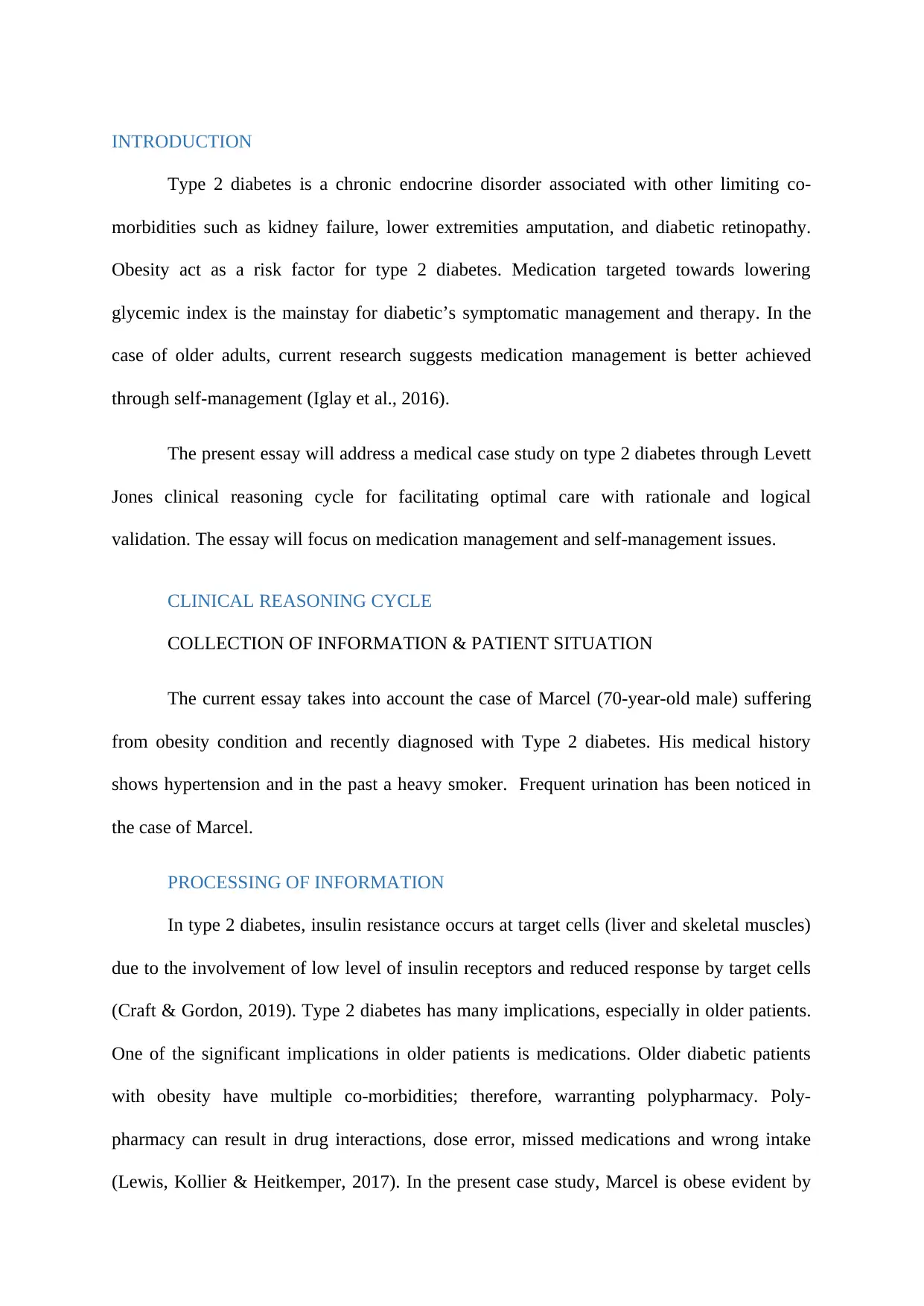
INTRODUCTION
Type 2 diabetes is a chronic endocrine disorder associated with other limiting co-
morbidities such as kidney failure, lower extremities amputation, and diabetic retinopathy.
Obesity act as a risk factor for type 2 diabetes. Medication targeted towards lowering
glycemic index is the mainstay for diabetic’s symptomatic management and therapy. In the
case of older adults, current research suggests medication management is better achieved
through self-management (Iglay et al., 2016).
The present essay will address a medical case study on type 2 diabetes through Levett
Jones clinical reasoning cycle for facilitating optimal care with rationale and logical
validation. The essay will focus on medication management and self-management issues.
CLINICAL REASONING CYCLE
COLLECTION OF INFORMATION & PATIENT SITUATION
The current essay takes into account the case of Marcel (70-year-old male) suffering
from obesity condition and recently diagnosed with Type 2 diabetes. His medical history
shows hypertension and in the past a heavy smoker. Frequent urination has been noticed in
the case of Marcel.
PROCESSING OF INFORMATION
In type 2 diabetes, insulin resistance occurs at target cells (liver and skeletal muscles)
due to the involvement of low level of insulin receptors and reduced response by target cells
(Craft & Gordon, 2019). Type 2 diabetes has many implications, especially in older patients.
One of the significant implications in older patients is medications. Older diabetic patients
with obesity have multiple co-morbidities; therefore, warranting polypharmacy. Poly-
pharmacy can result in drug interactions, dose error, missed medications and wrong intake
(Lewis, Kollier & Heitkemper, 2017). In the present case study, Marcel is obese evident by
Type 2 diabetes is a chronic endocrine disorder associated with other limiting co-
morbidities such as kidney failure, lower extremities amputation, and diabetic retinopathy.
Obesity act as a risk factor for type 2 diabetes. Medication targeted towards lowering
glycemic index is the mainstay for diabetic’s symptomatic management and therapy. In the
case of older adults, current research suggests medication management is better achieved
through self-management (Iglay et al., 2016).
The present essay will address a medical case study on type 2 diabetes through Levett
Jones clinical reasoning cycle for facilitating optimal care with rationale and logical
validation. The essay will focus on medication management and self-management issues.
CLINICAL REASONING CYCLE
COLLECTION OF INFORMATION & PATIENT SITUATION
The current essay takes into account the case of Marcel (70-year-old male) suffering
from obesity condition and recently diagnosed with Type 2 diabetes. His medical history
shows hypertension and in the past a heavy smoker. Frequent urination has been noticed in
the case of Marcel.
PROCESSING OF INFORMATION
In type 2 diabetes, insulin resistance occurs at target cells (liver and skeletal muscles)
due to the involvement of low level of insulin receptors and reduced response by target cells
(Craft & Gordon, 2019). Type 2 diabetes has many implications, especially in older patients.
One of the significant implications in older patients is medications. Older diabetic patients
with obesity have multiple co-morbidities; therefore, warranting polypharmacy. Poly-
pharmacy can result in drug interactions, dose error, missed medications and wrong intake
(Lewis, Kollier & Heitkemper, 2017). In the present case study, Marcel is obese evident by
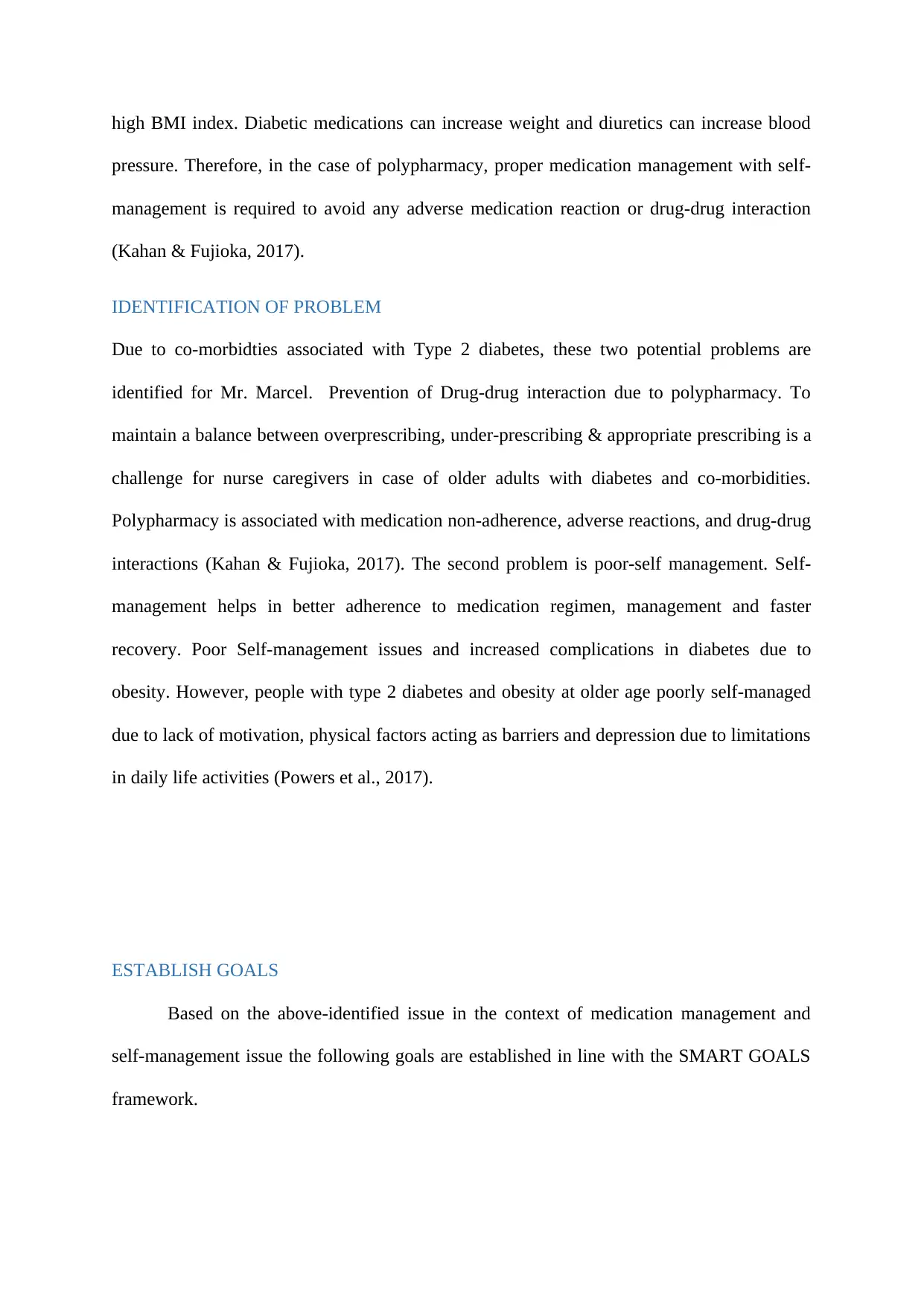
high BMI index. Diabetic medications can increase weight and diuretics can increase blood
pressure. Therefore, in the case of polypharmacy, proper medication management with self-
management is required to avoid any adverse medication reaction or drug-drug interaction
(Kahan & Fujioka, 2017).
IDENTIFICATION OF PROBLEM
Due to co-morbidties associated with Type 2 diabetes, these two potential problems are
identified for Mr. Marcel. Prevention of Drug-drug interaction due to polypharmacy. To
maintain a balance between overprescribing, under-prescribing & appropriate prescribing is a
challenge for nurse caregivers in case of older adults with diabetes and co-morbidities.
Polypharmacy is associated with medication non-adherence, adverse reactions, and drug-drug
interactions (Kahan & Fujioka, 2017). The second problem is poor-self management. Self-
management helps in better adherence to medication regimen, management and faster
recovery. Poor Self-management issues and increased complications in diabetes due to
obesity. However, people with type 2 diabetes and obesity at older age poorly self-managed
due to lack of motivation, physical factors acting as barriers and depression due to limitations
in daily life activities (Powers et al., 2017).
ESTABLISH GOALS
Based on the above-identified issue in the context of medication management and
self-management issue the following goals are established in line with the SMART GOALS
framework.
pressure. Therefore, in the case of polypharmacy, proper medication management with self-
management is required to avoid any adverse medication reaction or drug-drug interaction
(Kahan & Fujioka, 2017).
IDENTIFICATION OF PROBLEM
Due to co-morbidties associated with Type 2 diabetes, these two potential problems are
identified for Mr. Marcel. Prevention of Drug-drug interaction due to polypharmacy. To
maintain a balance between overprescribing, under-prescribing & appropriate prescribing is a
challenge for nurse caregivers in case of older adults with diabetes and co-morbidities.
Polypharmacy is associated with medication non-adherence, adverse reactions, and drug-drug
interactions (Kahan & Fujioka, 2017). The second problem is poor-self management. Self-
management helps in better adherence to medication regimen, management and faster
recovery. Poor Self-management issues and increased complications in diabetes due to
obesity. However, people with type 2 diabetes and obesity at older age poorly self-managed
due to lack of motivation, physical factors acting as barriers and depression due to limitations
in daily life activities (Powers et al., 2017).
ESTABLISH GOALS
Based on the above-identified issue in the context of medication management and
self-management issue the following goals are established in line with the SMART GOALS
framework.
Secure Best Marks with AI Grader
Need help grading? Try our AI Grader for instant feedback on your assignments.
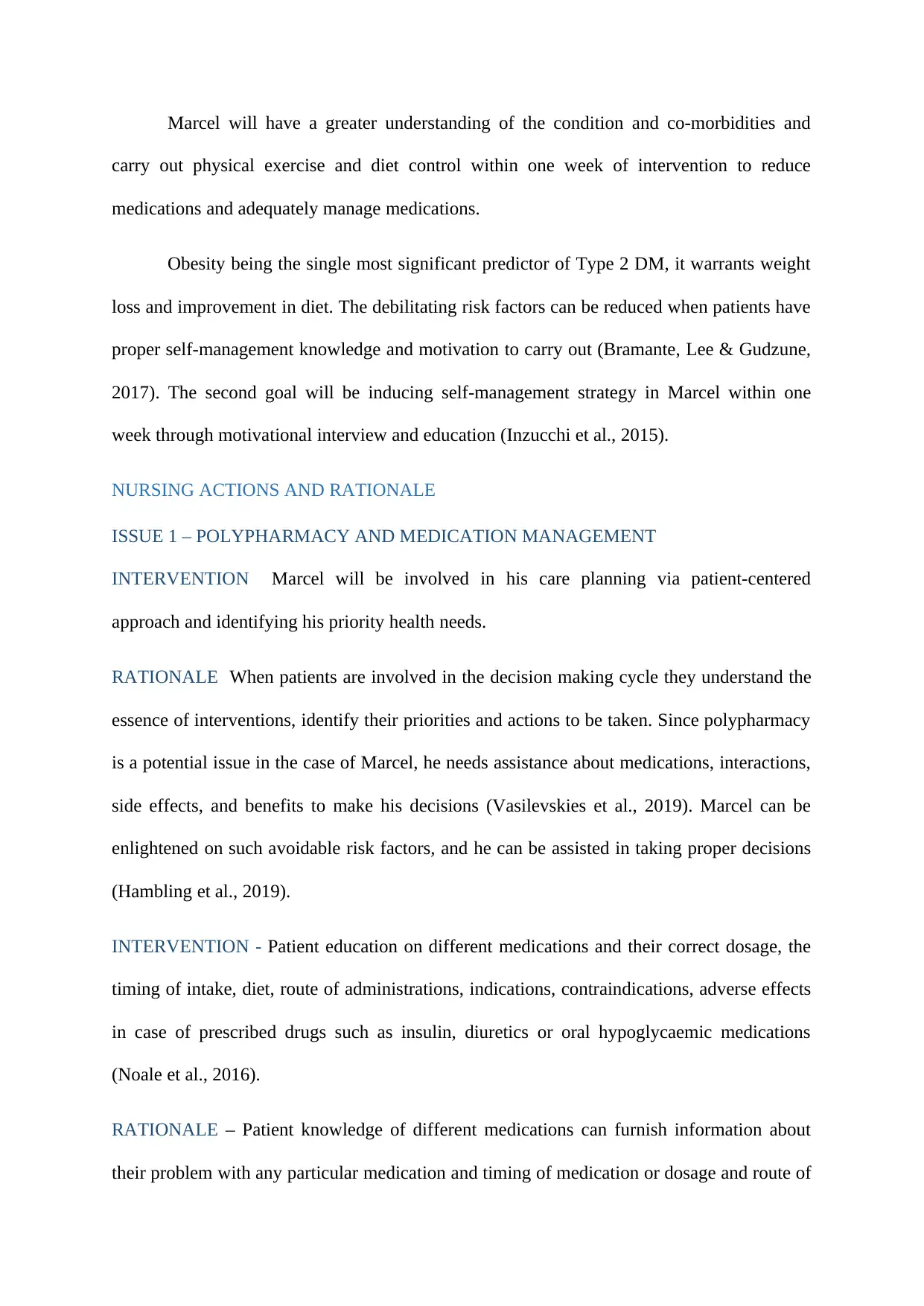
Marcel will have a greater understanding of the condition and co-morbidities and
carry out physical exercise and diet control within one week of intervention to reduce
medications and adequately manage medications.
Obesity being the single most significant predictor of Type 2 DM, it warrants weight
loss and improvement in diet. The debilitating risk factors can be reduced when patients have
proper self-management knowledge and motivation to carry out (Bramante, Lee & Gudzune,
2017). The second goal will be inducing self-management strategy in Marcel within one
week through motivational interview and education (Inzucchi et al., 2015).
NURSING ACTIONS AND RATIONALE
ISSUE 1 – POLYPHARMACY AND MEDICATION MANAGEMENT
INTERVENTION Marcel will be involved in his care planning via patient-centered
approach and identifying his priority health needs.
RATIONALE When patients are involved in the decision making cycle they understand the
essence of interventions, identify their priorities and actions to be taken. Since polypharmacy
is a potential issue in the case of Marcel, he needs assistance about medications, interactions,
side effects, and benefits to make his decisions (Vasilevskies et al., 2019). Marcel can be
enlightened on such avoidable risk factors, and he can be assisted in taking proper decisions
(Hambling et al., 2019).
INTERVENTION - Patient education on different medications and their correct dosage, the
timing of intake, diet, route of administrations, indications, contraindications, adverse effects
in case of prescribed drugs such as insulin, diuretics or oral hypoglycaemic medications
(Noale et al., 2016).
RATIONALE – Patient knowledge of different medications can furnish information about
their problem with any particular medication and timing of medication or dosage and route of
carry out physical exercise and diet control within one week of intervention to reduce
medications and adequately manage medications.
Obesity being the single most significant predictor of Type 2 DM, it warrants weight
loss and improvement in diet. The debilitating risk factors can be reduced when patients have
proper self-management knowledge and motivation to carry out (Bramante, Lee & Gudzune,
2017). The second goal will be inducing self-management strategy in Marcel within one
week through motivational interview and education (Inzucchi et al., 2015).
NURSING ACTIONS AND RATIONALE
ISSUE 1 – POLYPHARMACY AND MEDICATION MANAGEMENT
INTERVENTION Marcel will be involved in his care planning via patient-centered
approach and identifying his priority health needs.
RATIONALE When patients are involved in the decision making cycle they understand the
essence of interventions, identify their priorities and actions to be taken. Since polypharmacy
is a potential issue in the case of Marcel, he needs assistance about medications, interactions,
side effects, and benefits to make his decisions (Vasilevskies et al., 2019). Marcel can be
enlightened on such avoidable risk factors, and he can be assisted in taking proper decisions
(Hambling et al., 2019).
INTERVENTION - Patient education on different medications and their correct dosage, the
timing of intake, diet, route of administrations, indications, contraindications, adverse effects
in case of prescribed drugs such as insulin, diuretics or oral hypoglycaemic medications
(Noale et al., 2016).
RATIONALE – Patient knowledge of different medications can furnish information about
their problem with any particular medication and timing of medication or dosage and route of
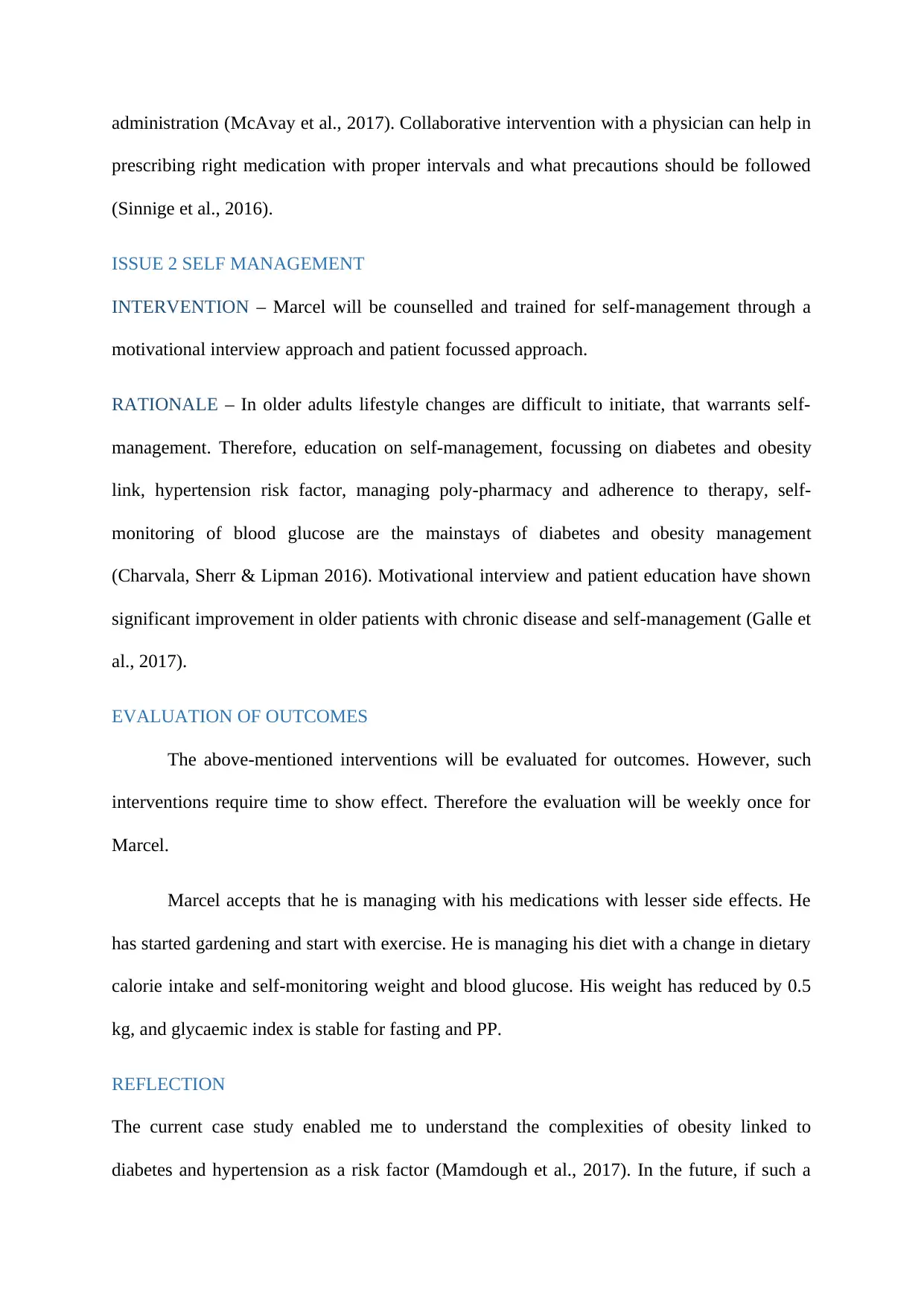
administration (McAvay et al., 2017). Collaborative intervention with a physician can help in
prescribing right medication with proper intervals and what precautions should be followed
(Sinnige et al., 2016).
ISSUE 2 SELF MANAGEMENT
INTERVENTION – Marcel will be counselled and trained for self-management through a
motivational interview approach and patient focussed approach.
RATIONALE – In older adults lifestyle changes are difficult to initiate, that warrants self-
management. Therefore, education on self-management, focussing on diabetes and obesity
link, hypertension risk factor, managing poly-pharmacy and adherence to therapy, self-
monitoring of blood glucose are the mainstays of diabetes and obesity management
(Charvala, Sherr & Lipman 2016). Motivational interview and patient education have shown
significant improvement in older patients with chronic disease and self-management (Galle et
al., 2017).
EVALUATION OF OUTCOMES
The above-mentioned interventions will be evaluated for outcomes. However, such
interventions require time to show effect. Therefore the evaluation will be weekly once for
Marcel.
Marcel accepts that he is managing with his medications with lesser side effects. He
has started gardening and start with exercise. He is managing his diet with a change in dietary
calorie intake and self-monitoring weight and blood glucose. His weight has reduced by 0.5
kg, and glycaemic index is stable for fasting and PP.
REFLECTION
The current case study enabled me to understand the complexities of obesity linked to
diabetes and hypertension as a risk factor (Mamdough et al., 2017). In the future, if such a
prescribing right medication with proper intervals and what precautions should be followed
(Sinnige et al., 2016).
ISSUE 2 SELF MANAGEMENT
INTERVENTION – Marcel will be counselled and trained for self-management through a
motivational interview approach and patient focussed approach.
RATIONALE – In older adults lifestyle changes are difficult to initiate, that warrants self-
management. Therefore, education on self-management, focussing on diabetes and obesity
link, hypertension risk factor, managing poly-pharmacy and adherence to therapy, self-
monitoring of blood glucose are the mainstays of diabetes and obesity management
(Charvala, Sherr & Lipman 2016). Motivational interview and patient education have shown
significant improvement in older patients with chronic disease and self-management (Galle et
al., 2017).
EVALUATION OF OUTCOMES
The above-mentioned interventions will be evaluated for outcomes. However, such
interventions require time to show effect. Therefore the evaluation will be weekly once for
Marcel.
Marcel accepts that he is managing with his medications with lesser side effects. He
has started gardening and start with exercise. He is managing his diet with a change in dietary
calorie intake and self-monitoring weight and blood glucose. His weight has reduced by 0.5
kg, and glycaemic index is stable for fasting and PP.
REFLECTION
The current case study enabled me to understand the complexities of obesity linked to
diabetes and hypertension as a risk factor (Mamdough et al., 2017). In the future, if such a
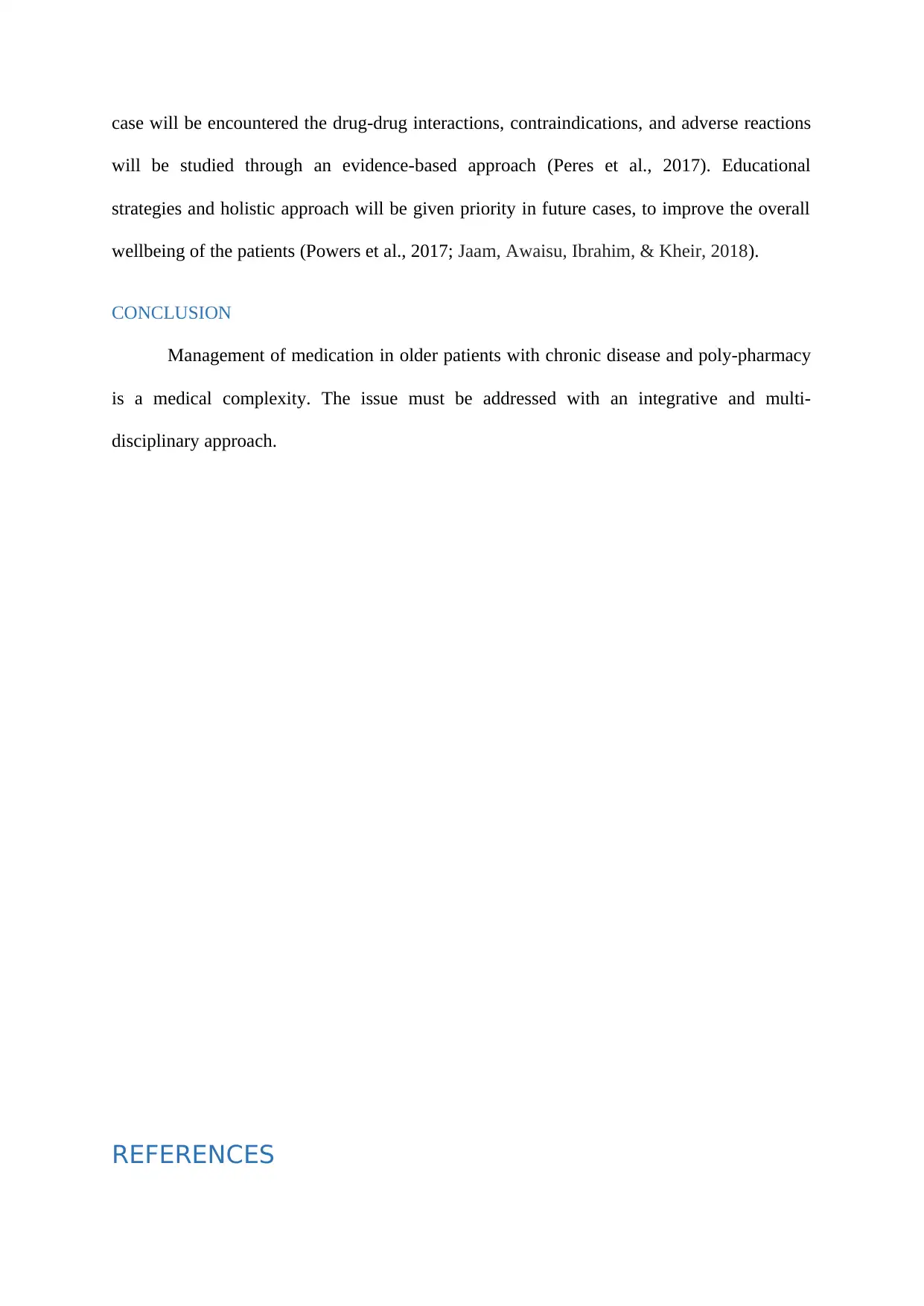
case will be encountered the drug-drug interactions, contraindications, and adverse reactions
will be studied through an evidence-based approach (Peres et al., 2017). Educational
strategies and holistic approach will be given priority in future cases, to improve the overall
wellbeing of the patients (Powers et al., 2017; Jaam, Awaisu, Ibrahim, & Kheir, 2018).
CONCLUSION
Management of medication in older patients with chronic disease and poly-pharmacy
is a medical complexity. The issue must be addressed with an integrative and multi-
disciplinary approach.
REFERENCES
will be studied through an evidence-based approach (Peres et al., 2017). Educational
strategies and holistic approach will be given priority in future cases, to improve the overall
wellbeing of the patients (Powers et al., 2017; Jaam, Awaisu, Ibrahim, & Kheir, 2018).
CONCLUSION
Management of medication in older patients with chronic disease and poly-pharmacy
is a medical complexity. The issue must be addressed with an integrative and multi-
disciplinary approach.
REFERENCES
Paraphrase This Document
Need a fresh take? Get an instant paraphrase of this document with our AI Paraphraser
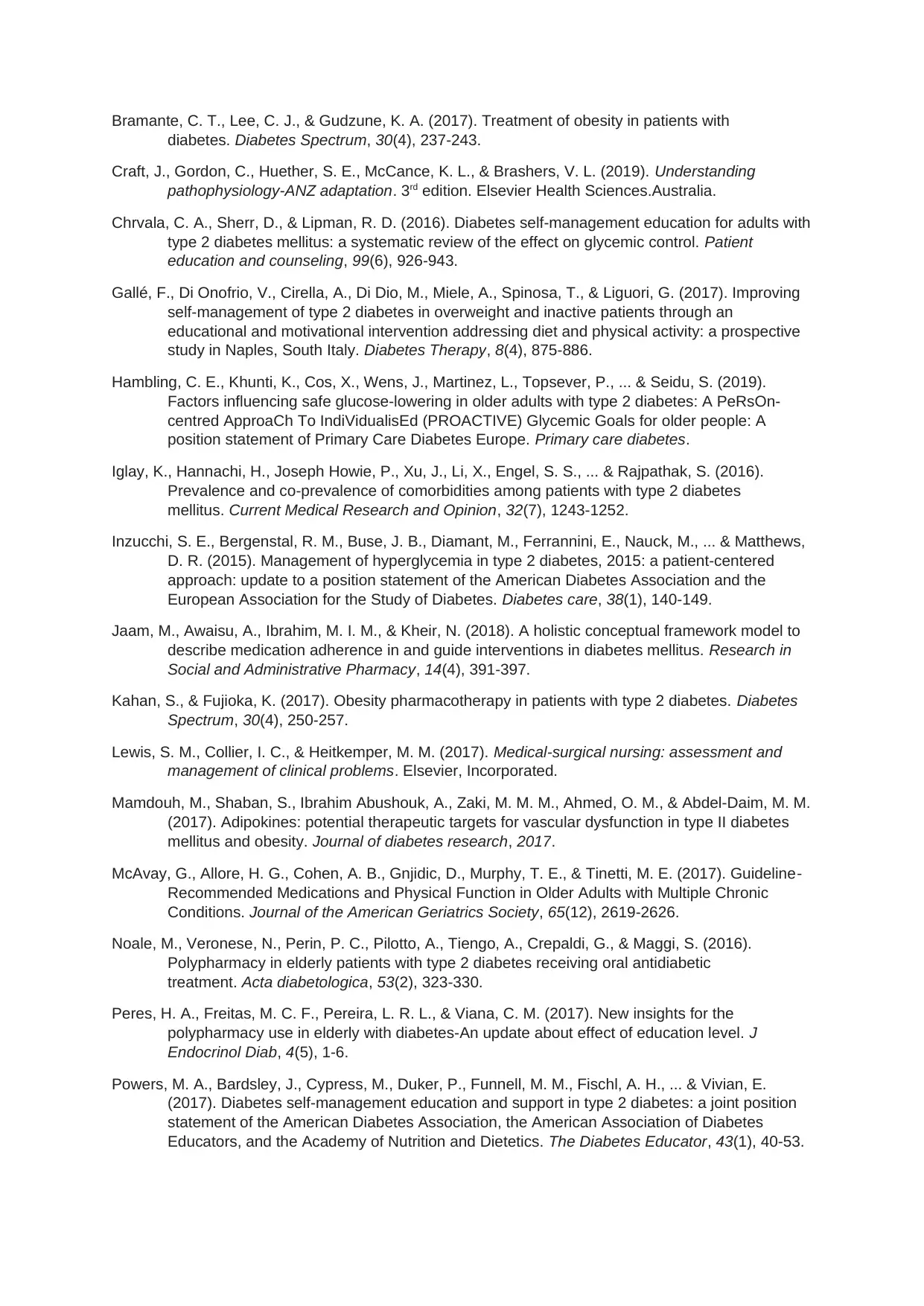
Bramante, C. T., Lee, C. J., & Gudzune, K. A. (2017). Treatment of obesity in patients with
diabetes. Diabetes Spectrum, 30(4), 237-243.
Craft, J., Gordon, C., Huether, S. E., McCance, K. L., & Brashers, V. L. (2019). Understanding
pathophysiology-ANZ adaptation. 3rd edition. Elsevier Health Sciences.Australia.
Chrvala, C. A., Sherr, D., & Lipman, R. D. (2016). Diabetes self-management education for adults with
type 2 diabetes mellitus: a systematic review of the effect on glycemic control. Patient
education and counseling, 99(6), 926-943.
Gallé, F., Di Onofrio, V., Cirella, A., Di Dio, M., Miele, A., Spinosa, T., & Liguori, G. (2017). Improving
self-management of type 2 diabetes in overweight and inactive patients through an
educational and motivational intervention addressing diet and physical activity: a prospective
study in Naples, South Italy. Diabetes Therapy, 8(4), 875-886.
Hambling, C. E., Khunti, K., Cos, X., Wens, J., Martinez, L., Topsever, P., ... & Seidu, S. (2019).
Factors influencing safe glucose-lowering in older adults with type 2 diabetes: A PeRsOn-
centred ApproaCh To IndiVidualisEd (PROACTIVE) Glycemic Goals for older people: A
position statement of Primary Care Diabetes Europe. Primary care diabetes.
Iglay, K., Hannachi, H., Joseph Howie, P., Xu, J., Li, X., Engel, S. S., ... & Rajpathak, S. (2016).
Prevalence and co-prevalence of comorbidities among patients with type 2 diabetes
mellitus. Current Medical Research and Opinion, 32(7), 1243-1252.
Inzucchi, S. E., Bergenstal, R. M., Buse, J. B., Diamant, M., Ferrannini, E., Nauck, M., ... & Matthews,
D. R. (2015). Management of hyperglycemia in type 2 diabetes, 2015: a patient-centered
approach: update to a position statement of the American Diabetes Association and the
European Association for the Study of Diabetes. Diabetes care, 38(1), 140-149.
Jaam, M., Awaisu, A., Ibrahim, M. I. M., & Kheir, N. (2018). A holistic conceptual framework model to
describe medication adherence in and guide interventions in diabetes mellitus. Research in
Social and Administrative Pharmacy, 14(4), 391-397.
Kahan, S., & Fujioka, K. (2017). Obesity pharmacotherapy in patients with type 2 diabetes. Diabetes
Spectrum, 30(4), 250-257.
Lewis, S. M., Collier, I. C., & Heitkemper, M. M. (2017). Medical-surgical nursing: assessment and
management of clinical problems. Elsevier, Incorporated.
Mamdouh, M., Shaban, S., Ibrahim Abushouk, A., Zaki, M. M. M., Ahmed, O. M., & Abdel-Daim, M. M.
(2017). Adipokines: potential therapeutic targets for vascular dysfunction in type II diabetes
mellitus and obesity. Journal of diabetes research, 2017.
McAvay, G., Allore, H. G., Cohen, A. B., Gnjidic, D., Murphy, T. E., & Tinetti, M. E. (2017). Guideline‐
Recommended Medications and Physical Function in Older Adults with Multiple Chronic
Conditions. Journal of the American Geriatrics Society, 65(12), 2619-2626.
Noale, M., Veronese, N., Perin, P. C., Pilotto, A., Tiengo, A., Crepaldi, G., & Maggi, S. (2016).
Polypharmacy in elderly patients with type 2 diabetes receiving oral antidiabetic
treatment. Acta diabetologica, 53(2), 323-330.
Peres, H. A., Freitas, M. C. F., Pereira, L. R. L., & Viana, C. M. (2017). New insights for the
polypharmacy use in elderly with diabetes-An update about effect of education level. J
Endocrinol Diab, 4(5), 1-6.
Powers, M. A., Bardsley, J., Cypress, M., Duker, P., Funnell, M. M., Fischl, A. H., ... & Vivian, E.
(2017). Diabetes self-management education and support in type 2 diabetes: a joint position
statement of the American Diabetes Association, the American Association of Diabetes
Educators, and the Academy of Nutrition and Dietetics. The Diabetes Educator, 43(1), 40-53.
diabetes. Diabetes Spectrum, 30(4), 237-243.
Craft, J., Gordon, C., Huether, S. E., McCance, K. L., & Brashers, V. L. (2019). Understanding
pathophysiology-ANZ adaptation. 3rd edition. Elsevier Health Sciences.Australia.
Chrvala, C. A., Sherr, D., & Lipman, R. D. (2016). Diabetes self-management education for adults with
type 2 diabetes mellitus: a systematic review of the effect on glycemic control. Patient
education and counseling, 99(6), 926-943.
Gallé, F., Di Onofrio, V., Cirella, A., Di Dio, M., Miele, A., Spinosa, T., & Liguori, G. (2017). Improving
self-management of type 2 diabetes in overweight and inactive patients through an
educational and motivational intervention addressing diet and physical activity: a prospective
study in Naples, South Italy. Diabetes Therapy, 8(4), 875-886.
Hambling, C. E., Khunti, K., Cos, X., Wens, J., Martinez, L., Topsever, P., ... & Seidu, S. (2019).
Factors influencing safe glucose-lowering in older adults with type 2 diabetes: A PeRsOn-
centred ApproaCh To IndiVidualisEd (PROACTIVE) Glycemic Goals for older people: A
position statement of Primary Care Diabetes Europe. Primary care diabetes.
Iglay, K., Hannachi, H., Joseph Howie, P., Xu, J., Li, X., Engel, S. S., ... & Rajpathak, S. (2016).
Prevalence and co-prevalence of comorbidities among patients with type 2 diabetes
mellitus. Current Medical Research and Opinion, 32(7), 1243-1252.
Inzucchi, S. E., Bergenstal, R. M., Buse, J. B., Diamant, M., Ferrannini, E., Nauck, M., ... & Matthews,
D. R. (2015). Management of hyperglycemia in type 2 diabetes, 2015: a patient-centered
approach: update to a position statement of the American Diabetes Association and the
European Association for the Study of Diabetes. Diabetes care, 38(1), 140-149.
Jaam, M., Awaisu, A., Ibrahim, M. I. M., & Kheir, N. (2018). A holistic conceptual framework model to
describe medication adherence in and guide interventions in diabetes mellitus. Research in
Social and Administrative Pharmacy, 14(4), 391-397.
Kahan, S., & Fujioka, K. (2017). Obesity pharmacotherapy in patients with type 2 diabetes. Diabetes
Spectrum, 30(4), 250-257.
Lewis, S. M., Collier, I. C., & Heitkemper, M. M. (2017). Medical-surgical nursing: assessment and
management of clinical problems. Elsevier, Incorporated.
Mamdouh, M., Shaban, S., Ibrahim Abushouk, A., Zaki, M. M. M., Ahmed, O. M., & Abdel-Daim, M. M.
(2017). Adipokines: potential therapeutic targets for vascular dysfunction in type II diabetes
mellitus and obesity. Journal of diabetes research, 2017.
McAvay, G., Allore, H. G., Cohen, A. B., Gnjidic, D., Murphy, T. E., & Tinetti, M. E. (2017). Guideline‐
Recommended Medications and Physical Function in Older Adults with Multiple Chronic
Conditions. Journal of the American Geriatrics Society, 65(12), 2619-2626.
Noale, M., Veronese, N., Perin, P. C., Pilotto, A., Tiengo, A., Crepaldi, G., & Maggi, S. (2016).
Polypharmacy in elderly patients with type 2 diabetes receiving oral antidiabetic
treatment. Acta diabetologica, 53(2), 323-330.
Peres, H. A., Freitas, M. C. F., Pereira, L. R. L., & Viana, C. M. (2017). New insights for the
polypharmacy use in elderly with diabetes-An update about effect of education level. J
Endocrinol Diab, 4(5), 1-6.
Powers, M. A., Bardsley, J., Cypress, M., Duker, P., Funnell, M. M., Fischl, A. H., ... & Vivian, E.
(2017). Diabetes self-management education and support in type 2 diabetes: a joint position
statement of the American Diabetes Association, the American Association of Diabetes
Educators, and the Academy of Nutrition and Dietetics. The Diabetes Educator, 43(1), 40-53.

Sinnige, J., Korevaar, J. C., van Lieshout, J., Westert, G. P., Schellevis, F. G., & Braspenning, J. C.
(2016). Medication management strategy for older people with polypharmacy in general
practice: a qualitative study on prescribing behaviour in primary care. Br J Gen
Pract, 66(649), e540-e551.
Vasilevskis, E. E., Shah, A. S., Hollingsworth, E. K., Shotwell, M. S., Mixon, A. S., Bell, S. P., ... &
Simmons, S. F. (2019). A patient-centered deprescribing intervention for hospitalized older
patients with polypharmacy: rationale and design of the Shed-MEDS randomized controlled
trial. BMC health services research, 19(1), 165.
(2016). Medication management strategy for older people with polypharmacy in general
practice: a qualitative study on prescribing behaviour in primary care. Br J Gen
Pract, 66(649), e540-e551.
Vasilevskis, E. E., Shah, A. S., Hollingsworth, E. K., Shotwell, M. S., Mixon, A. S., Bell, S. P., ... &
Simmons, S. F. (2019). A patient-centered deprescribing intervention for hospitalized older
patients with polypharmacy: rationale and design of the Shed-MEDS randomized controlled
trial. BMC health services research, 19(1), 165.
1 out of 9
Related Documents
Your All-in-One AI-Powered Toolkit for Academic Success.
+13062052269
info@desklib.com
Available 24*7 on WhatsApp / Email
![[object Object]](/_next/static/media/star-bottom.7253800d.svg)
Unlock your academic potential
© 2024 | Zucol Services PVT LTD | All rights reserved.





